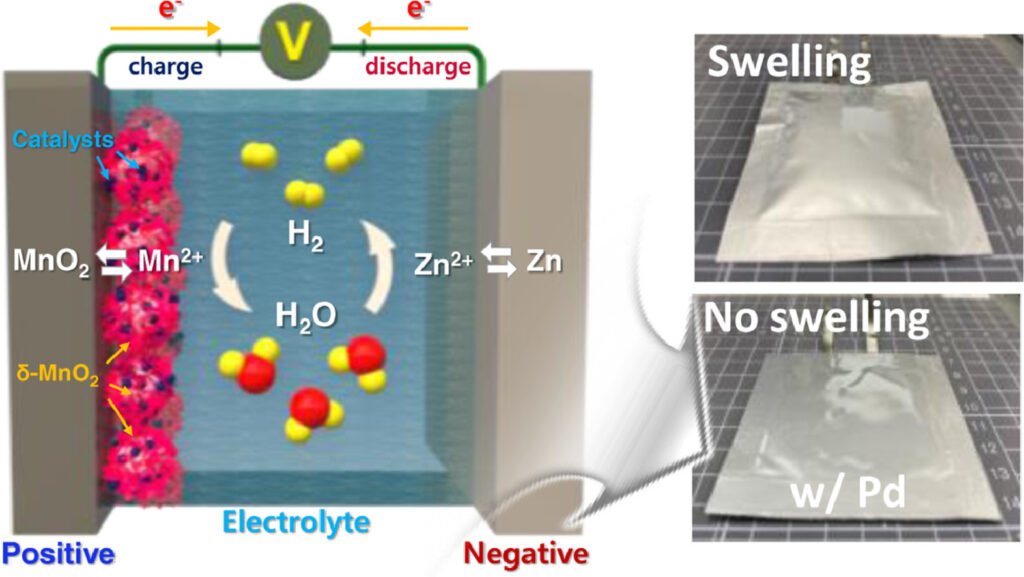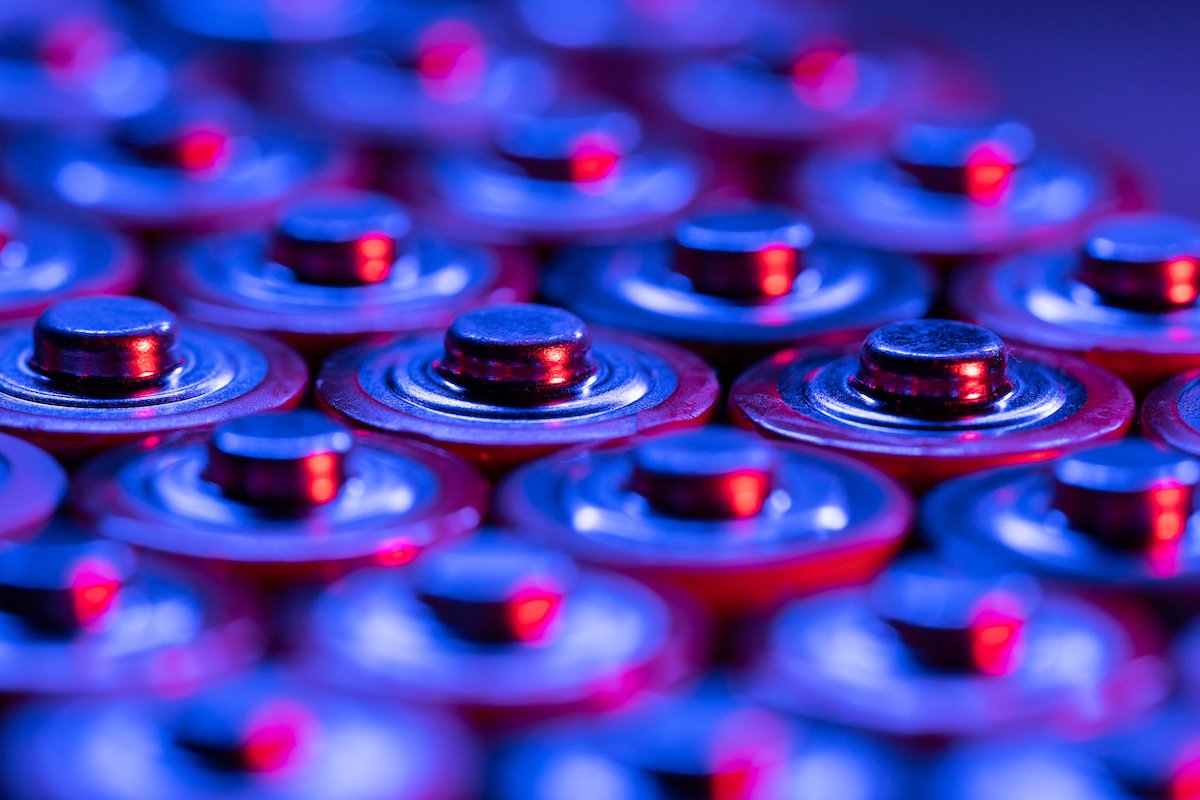Lithium-ion batteries (LIBs) have played a vital role in building a future increasingly reliant on portable electronics and renewable energy sources. However, power limitations and environmental issues have plagued the LIB market.
While alternatives like aqueous rechargeable batteries (ARBs) have always represented a potential replacement–and a greener one–they have a downside: they can potentially explode.
Now, new research led by Dr. Si Hyoung Oh and researchers at the Korea Institute of Science and Technology (KIST) Energy Storage Research Center may have helped resolve this issue by developing a novel aqueous rechargeable battery that stands as a potential contender to replace the ubiquitous lithium-ion batteries.
The cornerstone of this innovation lies in addressing a longstanding safety hurdle associated with aqueous batteries: the hazardous accumulation of hydrogen gas due to parasitic water decomposition. This issue has been a significant barrier to commercializing aqueous batteries despite their economic advantage due to the lower cost of raw materials compared to lithium-ion batteries.
What are Aqueous Rechargeable Batteries?
Aqueous rechargeable batteries utilize water-based solutions as electrolytes, in contrast to the organic solvents used in traditional lithium-ion batteries. This design choice makes ARBs safer and more cost-effective. During the charge and discharge cycles, ions travel between the two electrodes – the cathode and anode. In zinc-ion batteries, a type of ARB, zinc metal moves to the cathode when discharging and returns to the anode when charging.
These batteries, composed of a manganese dioxide (MnO2) cathode and zinc (Zn) metal anode in a mildly acidic electrolyte, have been identified as viable candidates to meet the rising demands for superior energy storage systems, thanks to their high safety features, cost-effectiveness, and environmental sustainability. However, a significant concern has been the unregulated dendrite growth and corrosion of metal deposits within the battery, which could undermine its safety and performance.
In simple terms, as the metals in the battery break down, they create hydrogen. Run the battery long enough, and as that hydrogen builds up inside it, it all goes, to word it scientifically, “kaboom.”
Previous efforts to mitigate this issue revolved around installing protective layers on the zinc metal surface or applying electrolyte additives to prevent direct water contact. Nonetheless, these measures only offered partial solutions as they didn’t address the root cause of the problem – the thermodynamic instability of zinc metal in an aqueous solution.
The KIST team, however, embarked on a fundamentally different approach to tackle this issue.
The KIST research team has navigated this challenge by developing a composite catalyst composed of manganese dioxide and palladium. Under normal circumstances, manganese dioxide remains unreactive with hydrogen gas. However, by adding a small amount of palladium, the catalyst readily absorbs the hydrogen, regenerating it into water. This ingenious solution not only alleviates the internal pressure but also prevents electrolyte depletion, thus ensuring the battery’s performance and safety. In their prototype cell equipped with the new catalysts, the internal pressure remained well below the safety threshold, demonstrating the effectiveness of their solution in real-world conditions.


So No More “Kaboom?”
Published in the journal Energy Storage Materials, this development signifies a monumental stride towards the commercial viability of aqueous batteries, especially in energy storage systems. Whether it is a smartphone or electric vehicle battery, the ripple effects of this advancement could trigger a rapid expansion in the global market for energy storage, which is currently dominated by lithium-ion batteries. Beyond the realm of batteries, the technology harbors the potential for addressing hydrogen gas leakage in various industrial facilities, like hydrogen gas stations and nuclear power plants, where such leakage is a significant safety concern.
“This technology pertains to a customized safety strategy for aqueous rechargeable batteries, based on the built-in active safety mechanism, through which risk factors are automatically controlled,” said Dr. Oh. “Moreover, it can be applied to various industrial facilities where hydrogen gas leakage is one of major safety concerns (for instance, hydrogen gas station, nuclear power plants, etc.) to protect public safety.”
What are the Differences Between Lithium-Ion Batteries and Aqueous Rechargeable Batteries?
Here is a quick run-down of the primary differences between the two energy sources:
Safety: LIBs are prone to thermal runaway and fires due to flammable organic solvents, while ARBs are safer due to water-based electrolytes, lowering fire and explosion risks.
Cost: LIBs have a higher cost of materials and manufacturing while ARBs utilize abundant, cheaper materials, potentially lowering production costs.
Environmental Impact: LIBs raise significant ecological concerns from lithium extraction and complex recycling processes. ARBs are much more environmentally friendly due to abundant and easily recyclable materials.
Energy Density: LIBs have a high energy density suitable for compact, lightweight applications like laptops and even a Tesla. ARBs traditionally have a much lower energy density, though advancements are bridging this gap.
Lifecycle: LIBs have a long lifecycle but can be affected by high temperatures and overcharging. ARBs have a promising future with longer lifecycles and lesser degradation over time.
Lithium-ion battery research is much more mature and established compared to aqueous batteries. LIBs dominate the battery market; however, new active research and development into ARBs is starting to overcome some of the challenges in this new technology.
A Greener Future?
The quest for superior battery technologies is a global endeavour. Researchers and organizations worldwide, including Dr. John Goodenough, the co-inventor of the lithium-ion battery, continue to explore alternatives and enhancements to the existing battery technologies. Moving humanity towards a greener future goes beyond simply jumping to a new solution but utilizing a collection of multiple green energy solutions. Whether it is solar power, “rain panels” or even artificial photosynthesis, the ecology and environment of the planet could very well be saved by micro-solutions that range across the proverbial board. These collective efforts propel the world towards a more sustainable and reliable energy landscape.
MJ Banias is a journalist and podcaster who covers security and technology. He is the host of The Debrief Weekly Report and Cloak & Dagger | An OSINT Podcast. Follow him on Twitter @mjbanias.

